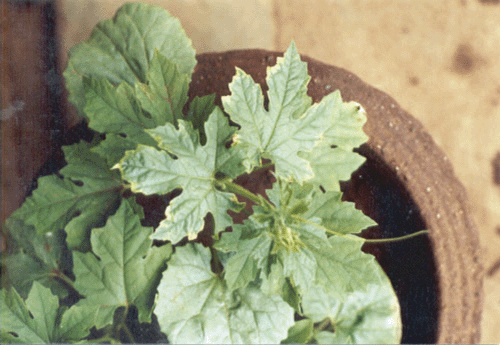First report of Indian cassava mosaic virus on bittergourd (Momordica charantia) in Tamil Nadu, India
N. Rajinimala A B and R. Rabindran AA Department of Plant Pathology, Tamil Nadu Agricultural University, Coimbatore 641 003, India.
B Corresponding author. Email: rajinimala@rediffmail.com
Australasian Plant Disease Notes 2(1) 81-82 https://doi.org/10.1071/DN07033
Submitted: 14 March 2007 Accepted: 7 May 2007 Published: 25 May 2007
Abstract
The association of Indian cassava mosaic virus (ICMV) with yellow mosaic disease of bittergourd (Momordica charantia) has been detected for the first time in Tamil Nadu, South India.
The association of Indian cassava mosaic virus (ICMV) with yellow mosaic disease of bittergourd (Momordica charantia) has been detected for the first time in Tamil Nadu, South India. Bittergourd is cultivated throughout the year in regions such as Andhra Pradesh, Maharashtra and Kerala. In Tamil Nadu it is grown in an area of ~26 004 ha with a production of 162 192 tonnes (Sidhu 1998). Begomovirus infection in bitter melon has previously been reported from Lucknow, India, by Khan et al. (2002), and an aphid-transmitted bittergourd mosaic virus was reported by Tomer and Mohan (2001). In the present study an epidemic form of yellow mosaic disease caused by Begomovirus in bittergourd was observed in Tamil Nadu.
The symptoms that characterise the yellow mosaic disease of bittergourd are first visible on young leaves as mosaic and mottling only. The mottling usually starts at the edges of the leaf and advance inwards (Fig. 1). Subsequently, chlorotic patches appear on leaves, and in advanced stages of infection, the entire leaf becomes chlorotic with few, small patches of green tissue remaining over the leaf area (Fig. 2). Blistering on leaves was also observed (Fig. 2). After attempts at mechanical inoculation the virus was not transmitted through sap from bittergourd to bittergourd, but the virus was positively transmitted by sap to Nicotiana benthamiana or through Whitefly (Bemisia tabaci) to herbaceous indicators (Mathew and Muniyappa 1993). Symptoms of rosetting were observed in Nicotiana benthamiana after sap inoculation (Fig. 3).

|

|

|
The infected leaf samples of bittergourd were tested for the presence of ICMV by triple antibody sandwich enzyme-linked immunosorbent assay (Muniyappa et al. 1991) using polyclonal antibody and monoclonal antibody kits of ICMV obtained from the Deutsche Sammlung von Mikroorganismen und Zellkulturen GmbH (DSMZ centre, German Collection of Microorganisms and Cell Cultures), Germany, catalogue numbers AS 0423 and AS 0424). For this experiment, an ICMV-infected leaf sample present in the kit was used as a positive control and phosphate buffer was used as a negative control. Absorbance (A405 nm) values were 1.625, 1.653, and 200 for the ICMV-infected bittergourd leaf sample, the positive control and the negative control, respectively.
The presence of ICMV was also confirmed using a degenerate primer pair for geminiviruses (Deng et al. 1997) and a specific primer pair for the ICMV coat protein region (Patil et al. 2005). The sizes of the amplified products were 560 bp and 800 bp, respectively (Fig. 4). The amplified product of the ICMV coat protein from bittergourd was cloned and sequenced. The sequence was submitted to GenBank (accession number DQ780004). The most similar protein within GenBank was the coat protein of ICMV from cassava (accession number AY998122; 99% similarity). To date there are no reports of ICMV on cultivated crops other than cassava in India. In our study we identified the occurrence of ICMV on bittergourd grown in Tamil Nadu, India.

|
Deng D,
Otim-Nape GW,
Sangare A,
Ogwal S,
Beachy RN, Fauquet CM
(1997) Presence of a new virus closely associated with cassava mosaic outbreak in Uganda. African Journal of Root and Tuber Crops 2, 23–28.
[Verified 9 May 2007]
Tomer SPS, Mohan J
(2001) Relationship of bittergourd mosaic virus with its aphid vectors. Journal of the Living World 8, 15–24.



